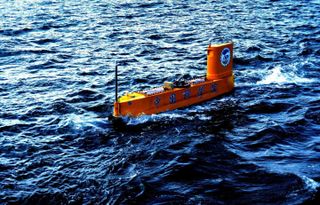China Tests World's 1st Robot Ship for Launching Small Rockets

China has built the world's first robotic, partially submersible boat for launching sounding rockets — a technology that will help meteorologists better understand the atmosphere over Earth's oceans.
Although the tests were conducted in 2016 and 2017, a paper describing the results of the first tests with the system has just been published. Traditionally, it's been difficult to study the three-quarters of the Earth's atmosphere that is found over water, because scientists have needed to do so from planes or ships, both of which make for expensive expeditions. These endeavours are also usually more vulnerable to inclement weather compared to land-based observations.
That's where China's new boat comes in. Officially classified as an "unmanned semisubmersible vehicle," the new ship is designed to sail into bad weather, deploy a sounding rocket, and gather crucial data about the atmosphere and ocean. [China in Space: The Latest Mission News]
Sounding rockets make brief flights through different layers of the atmosphere, in this case carrying meteorological equipment as high as 5 miles (8 kilometers) above the ocean.
"The unmanned semisubmersible vehicle is an ideal platform for marine meteorological environmental monitoring, and the atmospheric profile information provided by [sounding rockets] launched from this platform can improve the accuracy of numerical weather forecasts at sea and in coastal zones," co-author Jun Li, a researcher at the Institute of Atmospheric Physics of the Chinese Academy of Sciences, said in a statement accompanying the new paper.
Now, with these initial tests of the system complete, the team hopes to deploy a network of these boats, particularly in order to study typhoons, the equivalent of hurricanes in the western Pacific Ocean. They also hope to equip the boats themselves with more-advanced oceanography sensors, so the vessels can look down as well as up.
The test launches are described in a paper published Jan. 31 in the journal Advances in Atmospheric Science.
Sign up for the Live Science daily newsletter now
Get the world’s most fascinating discoveries delivered straight to your inbox.
Email Meghan Bartels at mbartels@space.com or follow her @meghanbartels. Follow us @Spacedotcom and Facebook. Original article on Space.com.
Meghan is a senior writer at Space.com and has more than five years' experience as a science journalist based in New York City. She joined Space.com in July 2018, with previous writing published in outlets including Newsweek and Audubon. Meghan earned an MA in science journalism from New York University and a BA in classics from Georgetown University, and in her free time she enjoys reading and visiting museums. Follow her on Twitter at @meghanbartels.

Researchers solve mystery of inexplicably dense galaxy at the heart of perfect 'Einstein ring' snapped by James Webb telescope

Lyrid meteor shower 2024: How to watch stunning shooting stars and 'fireballs' during the event's peak this week

50-foot 'king of the serpents' may have been the biggest snake to ever live
